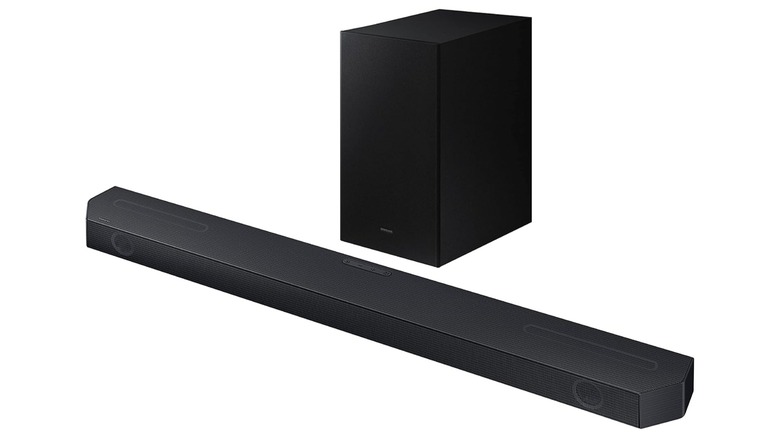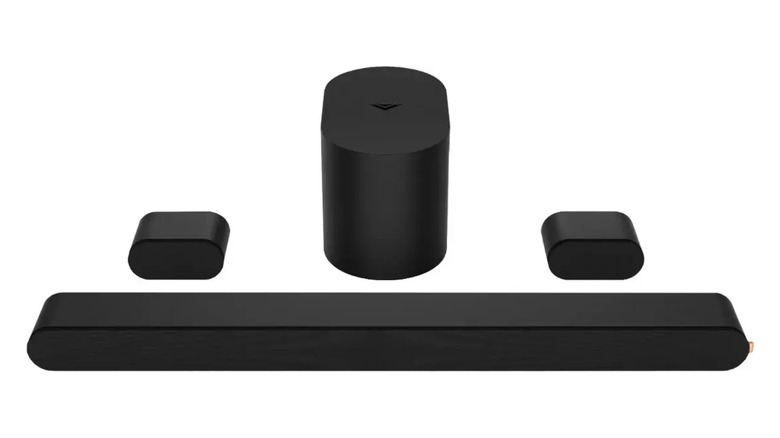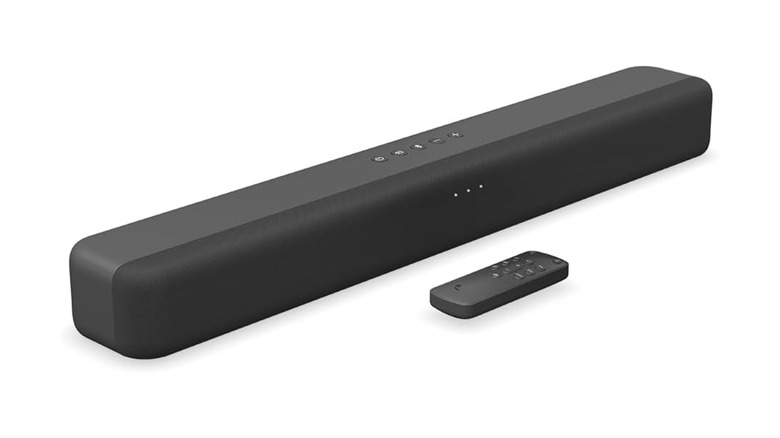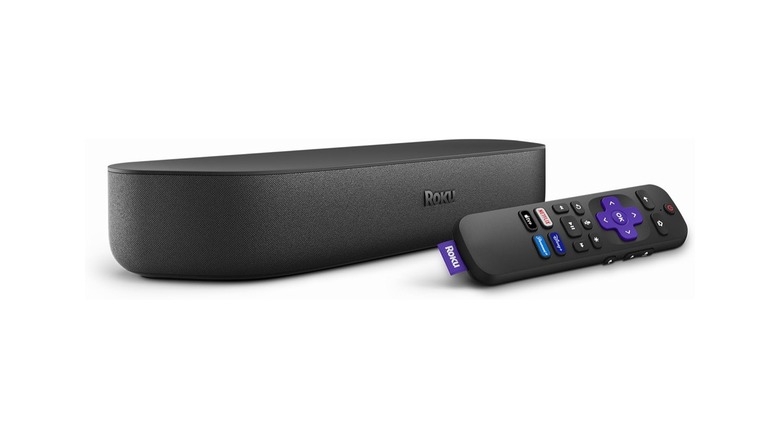The Pros And Cons Of Budget-Friendly Soundbars & Surround Sound Systems
We may receive a commission on purchases made from links.
Trying to get good audio for your electronics can be a surprisingly difficult task. Even when you rely on trustworthy major soundbar brands, getting a high-quality setup could cost more than your TV or monitor. Some potential buyers might want to focus on finding cheaper alternatives, sacrificing the overall quality for something that'll just give them the sound that they need. But how worthwhile are these cheaper systems compared to their more expensive counterparts?
There are many different types of sound system out there, and one of the most common is the soundbar. These products act as external speakers for whatever device you're watching from, and they're often paired with extras like a subwoofer to truly immerse listeners in their media.
As you start cutting costs, though, these systems can end up falling short of what you might come to expect — especially if you've experienced top-quality surround sound systems before. Therefore, it's important to consider the many pros and cons of buying a cheaper soundbar or sound system.
Pro: Better than TV/monitor speakers
In just about every instance, even a cheap soundbar will sound better than built-in speakers from a TV or computer monitor. Something like Sony's S100F soundbar might not be all that impressive on its own, but at least its speakers are facing toward the listener. TV and monitor speakers, due to prioritizing screen space and width, will often face their speakers down or even backward. This will lead to muffled voices and muddy music, assuming your display even has built-in speakers in the first place.
If you're getting a soundbar or sound system just because your display isn't handling audio well, you won't need to break the bank at all. The top-rated soundbars for PC and console gaming aren't much more than glorified speakers, but they'll almost always outdo whatever might be inside of your screen. These also won't cost you more than $100, which is a rarity when looking at top-quality sound systems. They might still fall short of competitors, but a bad soundbar is better than having no sound at all.
Pro: Subwoofers and rear speakers often included
If you're not willing to go above $300, you still have plenty of opportunities to get the full sound system experience. A large number of soundbars around this price range will come with extra hardware to provide even greater immersion. The Vizio 5.1 soundbar from is a prime example, offering both a subwoofer and surround speakers to offer an auditory experience that's as complete as possible. We also reviewed the similar-yet-more-expensive Vizio M-Series 5.1 Soundbar, noting how these extras allowed for some fantastic auditory moments during intense movies.
Sometimes, soundbars will even have subwoofers built-in to save on space. While it's generally agreed that external subwoofers sound better, built-in ones can usually still put out fine sound for most people. Vizio's V-Series 2.1 soundbar is one such device, and its pricing falls at the lower end of just under $120, making it a perfect pick for budget-conscious buyers. Even when considering the cost, it's not a bad idea to make sure your soundbar comes with at least one of these hardware extras.
Pro: Wireless at lower prices
Even at lower price points, soundbars can be a lot more flexible than you may think. The Amazon Fire TV Soundbar, for example, is one of the cheapest and most basic soundbars you can get. It lacks an internal subwoofer and doesn't have a lot of optional features, but it still allows you to connect to your display wirelessly. From $100 and upward, almost all soundbars allow for some form of wireless connectivity, particularly through Bluetooth.
Because of their wireless functionality, you can use these soundbars for more than just your TV or monitor. Connecting a phone or handheld console can work just as easily as connecting them to other wireless external speakers, and depending on your budget, it can have a much more immersive result. You can also take advantage of being untethered to simply move your soundbar closer to where you are. Thanks to this, even if the distance of your display makes it hard to hear some dialogue or music, you won't have to rely on just making it louder.
Pro: Some include extra features
While cheaper soundbars often lack the capabilities of full sound systems, they sometimes offer bonuses that aren't present in more expensive options. Take the Roku Streambar for example — the soundbar also doubles as a streaming device. Even when comparing the Roku Streambar's differences to the Roku Ultra, a more dedicated streaming player, it's still able to provide the same basic functionality and resolution. This puts its functionality far above other soundbars in multiple price ranges, simply because of how much you're able to do with it.
Other soundbars go the route of providing more "smart" functionality for homes. The Polk Audio React soundbar has Amazon Alexa built into it, which also allows you to call friends and family without the need of a phone. If your focus is on audio alone, you might still want to look at more dedicated setups to get as much quality out of a budget pick as possible. But as all-in-one solutions for those without streaming services or smart home devices, these soundbars are honestly pretty great value.
Pro: Countless secondhand options
If prices are simply far too high for you, there's always the option of buying secondhand sound systems from other sellers. You can easily find massive price cuts on refurbished devices from websites like eBay, sometimes bringing setups down from $300 to $150. With any luck, you can find normally costly setups at remarkably low prices, though this will depend on finding the right seller at the right moment.
As with any secondhand item, you should also be aware of any defects or wrong items you come across. Doing research on the various aspects of soundbars themselves can be just as important as researching the model you're after. Make sure you read each description carefully so someone claiming to have a "true surround sound" system doesn't leave you with something underpowered. Even so, if you're pushing to get the best sound for the cheapest price, this might be the only way you'll get it.
Con: Difficult to find under $100
The biggest problem with finding a "budget" soundbar is the fact that you'll still need to spend a lot of money for one. The only way you can find any of these under $100 is if you go for generic or online-only brands. The VMAI soundbar is one of the few you'll find under $100, offering plenty of basic functionality and even including a built-in subwoofer to sweeten the deal further. But if you're looking for long-term support or consistent quality, you're unlikely to get it at this price point.
Under $100, a soundbar isn't all that different from basic speakers like the Logitech Z313. You should take a close look at the pros and cons of soundbars versus speakers to see if the former is really what you need. If all you're doing is listening to things on your computer, you probably won't need to spend nearly as much money on a costly sound system. If you're after something that will give you a home theater experience, you're better off saving up for the more expensive alternatives.
Con: Budget systems lack hardware features
Even if they come with a subwoofer and extra speakers, some budget soundbars can lack very basic hardware functionality. Soundbars like the Hisense HS2100 will include a remote that allows you to adjust various settings like volume or bass & treble, but if you lose the remote, you won't be able to adjust those settings personally. Often, there simply won't be any buttons to raise or lower the volume or adjust other settings on the soundbar itself, potentially forcing you to deal with poor settings on an otherwise decent device.
The connectivity of certain cheaper soundbars can also be an issue. Most will have the ability to be plugged into other devices using an AUX or optical cable, but lower price points will make you lose out on additional HDMI connection options. This is a rarity even among cheaper soundbars, but it's something to be aware of if you're going for the least expensive possible option. In a worst-case scenario, you won't even be able to test your sound system until you get an entirely new device to plug it into.
Con: Not worthwhile without a subwoofer
How subwoofers actually work is by providing more bass to whatever you're listening to, picking up slack in lower frequencies where regular speakers simply won't cut it alone. Because of this, many audio enthusiasts recommend that you always get a sound system that includes one. Considering how even extra-cheap soundbars often come with this addition, whether built-in or external, it's almost impossible to lose out on them by accident. However, there are some low-cost soundbars that do not come with a subwoofer, and you should probably avoid them.
One particular soundbar without a subwoofer is the Hisense HS205G. Its list price of $80 makes it one of the least costly options you can find, but its capabilities are sorely lacking without a subwoofer. Some owners report that it doesn't even manage to surpass the volume of their basic built-in TV speakers. If you're willing to spend the extra money on a soundbar in the first place, you shouldn't settle for one that comes without the extra boost in audio performance.
Con: Might not support extra sound options
You'll probably expect a lack of support at cheaper price ranges for any device. Yet certain audio technologies like Dolby Audio and DTS are supported by a wide range of inexpensive soundbars, including the Samsung HW-T400. These technologies allow for more immersive sound — especially from movies — allowing even cheap soundbars to at least compare to more expensive ones. However, models like the Sony S100F do not support these technologies, leaving you unable to experience them no matter what.
At lower price points, you're also likely to miss out on more powerful sound systems. You're likely to only get to 2.0 or 2.1 surround sound with just $100, with the higher-standard 5.1 being reserved for $200 or higher. Of course, if you know the differences between 5.1, 7.1, and Dolby Atmos systems already, you probably know whether or not you'll actually need any of these extra features. But there are cheaper options that support these additions, leaving you with few reasons to avoid choosing them — much like soundbars with included subwoofers.
Con: Will always fall short of true audiophile options
If you consider yourself as an audiophile, you've likely experienced higher-end sound systems before. If that's the case, then pretty much any soundbar under $500 is likely to fall short of your expectations. Those who were able to use products like the Bose soundbars gave near-universal praise, only criticizing them for technical issues and when comparing them to similarly-priced soundbars from rival companies. To put things in comparison, Bose's flagship soundbar — the Smart Ultra Soundbar — has a list price of $900, and the company's cheapest option has a list price of around $280.
Someone that has little-to-no experience with these top-quality systems likely won't care about the differences. After all, even the cheapest soundbars still often sound better than the built-in speakers you'll find in TVs or monitors, as mentioned previously. But these pricier alternatives blow the competition out of the water entirely, satisfying those who went the extra mile to actually pay for those systems in the first place. It's all a matter of perspective when it comes to audio, so as long as what you get is better than your current setup, you probably won't find many reasons to complain.










